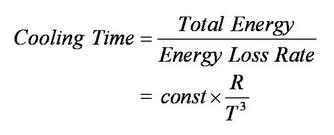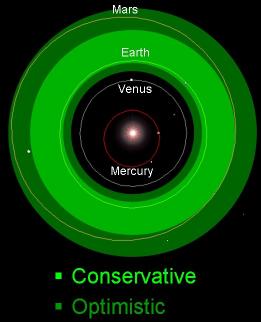

|
Astronomy 161:
An Introduction to Solar System Astronomy
Prof. Richard Pogge, MTWThF 2:30
|
Lecture 36:
Worlds in Comparison:
The Terrestrial Planets
Key Ideas:
A Comparison of the Terrestrial Planets
Surfaces & Interiors depend on size:
- Small bodies (Mercury, Mars, & Moon) have older
surfaces & colder interiors
- Large bodies (Venus & Earth) have younger surfaces
& hotter interiors
Atmospheres:
- All start with substantial atmospheres
- Evolution driven by the Greenhouse Effect
- Atmosphere Retention
The Habitable Zone
- Region where water can be liquid
The Terrestrial Planets
Large Bodies:
- Earth
- Venus (0.95 REarth, 0.82 MEarth)
Small Bodies:
- Mars (0.53 REarth, 0.11 MEarth)
- Mercury (0.38 REarth, 0.055 MEarth)
- Moon (0.27 REarth, 0.012 MEarth)
Evolution of Planetary Surfaces
The evolution of planetary surfaces is driven by three main processes:
- Impact cratering
- Volcanism
- Tectonism (crustal movement)
Volcanism & tectonism are driven by the internal structure of the
planets:
- Depends on whether the interior hot enough for volcanism
Small Planet Surfaces
Surfaces of the small terrestrial bodies, Mars, Mercury, & the Moon,
are distinguished from the Earth & Venus by being old and relatively
inactive:
- Old, heavily cratered surfaces >3 Gyr old
- Single, continuous crust (no plates)
- Vertical Tectonism dominates, primarily
stationary upwelling from below.
Crustal Shaping:
- Primary crust: shaped by impacts (highlands)
- Secondary crust: shaped by volcanism (hot-spot
volcanoes on Mars, Maria on the Moon, lava plains
on Mercury).
Large Planet Surfaces
The surfaces of the large terrestrial planets are younger and
active than those we see on the small terrestrial planets.
Younger Surfaces:
- Earth: most of the surface is <200 Myr old
- Venus: surface ~500 Myr old
Active "tertiary" crusts:
- Earth: plate tectonics (subduction, sea-floor
spreading, upthrust) rebuild crust constantly.
- Venus: volcanoes over mantle upwelling, and
compression over mantle downwelling (Venus has a
one-plate crust).
Evolution of Planetary Interiors
Internal heating & subsequent cooling drives the evolution
of planetary interiors:
First Stage: Differentiation (heat of formation)
- Dense molten metals sink into the core.
- Lighter silicate rocks float to the crust.
Second stage: Volcanism
- Mantle is still molten, primarily from internal heating
(radioactive decay) and heavy impacts.
- Magmas rise to the surface as volcanoes.
How fast the evolution proceeds depends on the Cooling Time
for the planet, determined by the heating and cooling balance.
Heating and Cooling
Start with the total amount of internal thermal energy in the planet:

The total energy scales like the volume times the temperature, and
since planets are roughly spherical, volume scales like radius cubed.
Hot planets cool by radiation losses from their surfaces:

This is the planet's surface area multiplied by the amount of energy
radiated per unit area from a Blackbody of temperature T given
by the
Stefan-Boltzmann Law.
In the absense of any additional sources of heating, the
Cooling Time is the total energy divided by the energy loss rate:

In words:
- Hotter Bodies cool faster.
- Larger Bodies cool slower.
This should square with our everyday experience: babies get cooler
faster on a cold day than football players, for example.
Terrestrial Planet Interiors
Small Bodies:
- Smaller bodies cool rapidly
- Mantles solidify, ending tectonic activity
- Thick, cool, rigid crusts
Large Bodies:
- Cool more slowly, and their hot interiors are kept hotter long
by extra heating from radioactive decay.
- Convective motions in the molten mantles drive tectonism, and
active (tertiary) resurfacing of the crust
Planetary Atmospheres
During formation, the terrestrial planets were molten from
impacts with planetesimals
- Fewer volatiles close to the Sun (too hot)
- Get more volatiles moving outwards (cooler)
Primordial Atmosphere Formation:
- Comet impacts deliver frozen volatiles from the outer
Solar System.
- Outgassing from primordial volcanoes
- Primary gases are CO2, H2O, & N2
- H & He quickly lost (gravity is too low)
All of the terrestrial planets started out with
substantial CO2, H2O vapor, and N2
atmospheres.
Evolution of Planetary Atmospheres
The evolution of a planetary atmosphere is driven by three major
factors:
Greenhouse Effect
- Affects the balance between solar heating and atmospheric cooling
- This in turn helps determine whether H2O is liquid, vapor,
or ice.
Planetary Gravity
- Determines the planet's ability to retain hot atoms and molecules.
Chemistry of CO2 and H2O
- CO2 is easily dissolved in liquid H2O.
- Help determine the atmospheric CO2 content, and
thus its contribution to the Greenhouse Effect.
The Greenhouse Effect
Makes surface temperatures warmer than they would be with no
atmosphere
| |
Without
Atmosphere |
With
Atmosphere |
Water |
| Earth |
255 K |
285 K |
Liquid |
| Venus |
280 K |
750 K |
Vapor |
| Mars |
214 K |
220 K |
Ice |
Data are from Bruce Jakowsky's article Atmospheres of the
Terrestrial Planets in The New Solar System, 4th
Edition, Beatty, Peterson, & Chaikin, eds, (1999, Cambridge University
Press).
Runaway Greenhouse Effect
The Greenhouse effect helps make terrestrial planets warmer than they
would be without atmospheres, but it can be an unstable process.
If the amount of solar heating increases (e.g., the Sun gets brighter), this
leads to an increase in the planet's surface temperature (air, ground, and any
oceans).
- If the planet has liquid water, the warmer temperatures increase the
amount of water vapor in the atmosphere.
- Water vapor is an effective greenhouse gas, so extra water vapor increases
greenhouse warming of the atmosphere.
Normally, if air has too much water vapor, it saturates and the water
vapor condenses and begins to rain out as a liquid, removing that much
water vapor as a greenhouse gas.
However, as the air gets warmer, it can also hold more water vapor before
becoming saturated and raining. Get it too warm, and you can start a
positive feedback loop:
- Warmer air leads to increased water evaporation,
- Warmer air also can hold more water vapor,
- More Water vapor means greater greenhouse absorption,
- Greater greenhouse absorption warms the atmosphere,
- Warmer air leads to more water evaporation...
and you start getting a Runaway Greenhouse Effect.
Eventually, the temperature get so high that you begin to evaporate the
oceans, releasing the dissolved CO2. This adds to the greenhouse
warming, increasing the temperature further.
After the oceans evaporate, the carbonaceous rock in the dried out
oceanic crust starts to decompose, releasing its huge load of CO2
into the super-heated atmosphere, increasing greenhouse absorption and
increasing the temperature further.
Atmospheric Retention
The other factor in determining what kind of atmosphere a planet will have
is its ability to hold onto its atmosphere.
More massive planets have a larger Escape Speeds, given by

The more massive the planet, the faster something must be moving to escape
from the planet into space.
Similarly, in a hot gas, the temperature is related to the speeds of the
individual atoms and molecules in the gas. The average thermal speed
of an atom or molecule is given by

Here at a given Temperature, Big molecules (bigger mass, m) move
slower.
Putting these two together:
- Massive planets can hold onto gases better than smaller planets
- Colder planets can hold onto gases better than warmer planets
Thus the ability of a planet to hold onto a particular molecule in gas
form depends on its mass and radius (which determines the escape speed)
and its temperature (which depends on how far it is from the Sun and
whether or not its atmosphere has a greenhouse effect operating).
Other factors can decrease the ability of a planet to retain gases, like
no magnetic fields to shield against the Solar Wind, or being
sufficiently warm that the atmosphere is extended (like Earth or Mars).
Mercury's Atmosphere
Mercury is too hot for liquid water:
- Shuts down CO2 and H2O chemistry
- Sets up a Runaway Greenhouse Effect
Mercury has a low surface gravity:
- Too small to hold onto its hot atmosphere
- Loses all its volatiles into space after only ~1 Gyr.
Result: Mercury has no atmosphere today.
Venus' Atmosphere
Venus is also too hot for liquid water:
- Might have had hot oceans very early that evaporated???
(still very speculative)
- Get a Runaway Greenhouse Effect
Venus is big enough to retain an atmosphere:
- Hot, heavy CO2 and N2 atmosphere
- H2 and O lost to UV photolysis, H2
escapes & the O reacts with other gasses.
Result: Venus has a very dry, super hot, heavy CO2
atmosphere today.
Earth's Atmosphere
Earth is cool enough for liquid water:
- H2O condenses into massive, deep oceans
- Setup a cycle of evaporation and precipitation in the atmosphere.
CO2 chemistry in water:
- Locks CO2 into carbonaceous rocks
- Plant life thrives with liquid water, converting gaseous CO2
into O2, boosting the atmosphere's O2 content.
- A mild greenhouse effect keeps water liquid.
Result: Earth has a light, warm, moist N2 &
O2 atmosphere today.
Mars' Atmosphere
Mars might have been warm enough for liquid water during its first Gyr:
- CO2 gets locked into carbonaceous rocks? This
is still a controversial idea.
- Evidence of liquid water in the past from the Mars Rovers
As Mars cooled:
- H2O froze out (most may already have been frozen into
saturated rocks)
- Much of the remaining CO2 and N2
escapes the low gravity of Mars
- Additional losses from the Solar Wind
Result: Mars has a dry, cold, thin CO2 atmosphere
today.
Present-day Atmospheres
The composition of present-day terrestrial planet atmospheres can
be summarized as follows:
| |
Earth |
Venus |
Mars |
| CO2 |
0.035% |
96% |
95% |
| N2 |
77% |
3.5% |
2.7% |
| H2O |
1% |
0.01% |
0.007% |
| Ar |
0.93% |
0.007% |
1.6% |
| O2 |
21% |
trace |
trace |
The Habitable Zone
What would happen if we moved the Earth closer to the Sun?
- Temperature would increase due to the greater solar heating.
- At a distance of 0.84-0.95 AU, extra solar heating is enough to
trigger a Runaway Greenhouse Effect.
- Earth would become like Venus is today.
What would happen if we moved the Earth away from the Sun?
- Temperature would decrease because of the reduced solar heating.
- At a distance of 1.4-1.5 AU, water would begin to freeze out (depends
somewhat on how well the greenhouse effect can keep the Earth warm).
- Get a frozen "Snowball Earth".
In between, where water can be liquid at normal atmospheric pressure,
is called the Habitable Zone.
- The Sun's Habitable Zone today

- [Click on the image for a full-size version]
There are two estimated ranges for the Habitable Zone in our Solar System:
- Conservative: 0.95-1.4AU
- Optimistic: 0.85-1.7AU
The more conservative estimate is based on the assumption that a runaway
greenhouse effect starts at a lower temperature, and that catastrophic
freeze-out occurs just before the orbit of Mars.
The more optimistic estimate has a higher temperature found closer in,
and that the greenhouse effect helps keep a heavier atmosphere like
Earth's warmer further away from the Sun.
Lessons for a Future Earth
As the Sun ages, it slowly gets brighter.
- This has the effect of moving the habitable zone further out
into the Solar System.
In ~1 Gyr, the Sun will be ~10% brighter:
- Extra sunlight at triggers a Moist Greenhouse Effect
- H2O vapor is lost to space, drying out the atmosphere
In ~3.5 Gyr, the Sun will be ~40% brighter:
- Extra sunlight triggers a Runaway Greenhouse Effect
- Oceans evaporate, making the Earth like Venus
Return to [
Unit 6 Index
|
Astronomy 161 Main Page
]
Updated: 2007 November 11
Copyright © Richard W. Pogge, All Rights Reserved.





